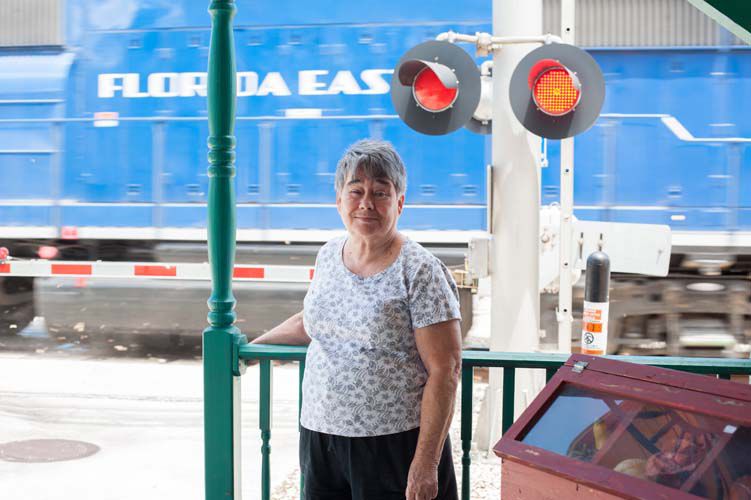The county commission threw some grit in the gears of All Aboard Florida’s high-speed rail scheme at its April 11 meeting, tabling legislation the company is seeking that would insure the county does not interfere with train operations at a county overpass.
Brevard County Commission Chair Curt Smith requested the delay to gain leverage in a dispute about the value of some easement property the county is buying from the railway.
“We got an appraisal,” said John Denninghoff, Brevard’s public works director. “But the railway wants about $300,000 without benefit of a valuation.
“They need to come up with their own appraisal.” Denninghoff said. “Then we can have a battle of experts.”
Smith said the delay is a negotiating chip. “With this tabled, we have some bargaining power,” he said.
Anything that slows the train down is fine with Betty Young, who is not a fan of the much-hyped and much-hated train expected to whisk passengers between Miami and Orlando in three hours. As proprietor of Betty’s Antiques in Historic Downtown Melbourne, Young will have to put up with the trains rumbling outside her window 32 times a day at speeds exceeding 79 miles per hour.
“I just don’t agree with it,” said Young, who has run her store for 25 years. “The freight trains are supposed to go 35 mph but they have to be doing 50.”
If it comes to be, All Aboard Florida’s planned high-speed rail service – dubbed Brightline – will more than double the train traffic by Young’s story. Besides utilizing the existing Florida East Coast Railway freight tracks, the company will build a second track alongside.
“It’s never going to fly,” Smith said of the service, which he believes offers nothing for the area. “We do not want a 100 mph train going through the county,” he said.
While All Aboard Florida and Brevard County duke it out, the first leg of the journey, from Miami to West Palm Beach, is expected to begin this year. The timing for latter phases depends on variables such as completion of track upgrades, installation of new track and financing – especially financing.
All Aboard had been notably unsuccessful, so far, in coaxing investors to climb aboard its risky scheme.
“We continue to explore financing options,” said Brightline spokeswoman AnneMarie Mathews.
The train, with speeds up to 125 mph, will stop at just three stations, none in Brevard even though the trains race through the county from Sebastian Inlet to Cocoa before banking west toward Orlando and the theme parks. A spokesperson for the train company says once operating, it will consider additional stations.
With that in mind, “The Space Coast Transportation Planning Organization reviewed potential locations from 528 south to Palm Bay. We endorsed two in Cocoa,” said TPO Executive Director, Bob Kamm.
Why not Melbourne, where travelers from Melbourne Beach, Indialantic, Indian Harbour Beach and Satellite Beach can hop aboard? Kamm said since All Aboard Florida is a for-profit business, a station needs to generate high numbers of passengers. “South county locations are unlikely to produce the riders that northern locations will.”
Smith said any station in Brevard would be a detriment to the high-speed Miami to Orlando concept. “If it stops in Brevard it blows the business model apart,” he said.
Critics who hope All Aboard Florida never gets on track insist it’s not a done deal. Two companies involved in the project had a change in ownership within the past two months. In February, Japanese company SoftBank Group Corp. bought Fortress Investment Group, the parent of All Aboard Florida. A month later, Grupo México acquired Florida East Coast Railway Holdings. What these acquisitions mean for the likelihood train service remains to be seen.
“We are happy a Japanese company bought Fortress. They know rail does not make money. The Mexican group is buying FECR to put money to double tracks for freight not passenger rail,” said Susan Meheil who represents a coalition of organizations that has fought All Aboard Florida for four years.
“My reason has always been about forcing 21st century systems onto 19th century infrastructure. It will impact the region negatively,” she said.
Sharing the tracks with freight trains – some carrying hazardous material – is a “recipe for disaster,” Meheil said.
Then there’s the money. Meheil says Brevard County attorney, Scott Knox, concluded the cost to maintain upgraded crossings would be at least double the current cost, not to mention retrofitting the streets leading up to the crossings.
Still, train officials say the project enjoys widespread Brevard support. “The county and cities realize the economic benefits and the increased connectivity a statewide system will bring to the region once it is implemented,” said Ali Soule, All Aboard Florida Public Affairs Manager. “We are also implementing a `sealed corridor’, which will qualify the county for quiet zone status, ie no horns. Brightline is installing these safety measures at no cost to local governments.”
A sealed corridor provides increased safety measures at grade crossings. “A train horn is considered part of grade crossing safety protection,” Kamm said. “So, if the horn is removed, other safety equipment must be installed in its place.”
Kamm added that All Aboard Florida is required to install additional safety equipment because of the speeds. “The equipment will also meet the requirements for quiet zones, a designation which applies to freight trains as well. When AAF is ready for grade crossing upgrades in our area, we will apply for quiet zone status for all 50+ crossings in Brevard,” he said.
Mathews says Brevard County also benefits because Brightline selected GE Transportation in Melbourne to design and manufacture of signaling equipment for the entire 235-mile corridor. Moreover, she claims during construction, the company will invest nearly $350 million in Brevard, creating over 1,000 jobs.

